Are you ready to unleash your creativity and explore the vibrant world of fruit painting? Whether you’re a beginner or an experienced artist, fruit paintings offer a delightful subject that can inspire and improve your painting skills. With the accessibility of watercolor and acrylic paints, you can easily create stunning artwork that captures the beauty of fruits.
In this article, I will share easy fruit painting ideas that will take your artwork to the next level. From tips for painting fruit to step-by-step tutorials, you’ll discover techniques and inspiration to create realistic and vibrant fruit paintings.
Key Takeaways:
- Create beautiful fruit paintings using watercolor and acrylic paints.
- Choose colors that are true to life and pay attention to details like seeds and textures.
- Experiment with light and shadow to add depth and dimension to your artwork.
- Explore watercolor fruit painting ideas with step-by-step tutorials.
- Discover acrylic fruit painting ideas from talented artists.
Tips for Painting Fruit
When it comes to fruit painting, there are a few key tips that can elevate your artwork from ordinary to extraordinary. Whether you’re a beginner or looking to hone your skills, these techniques will help you create realistic and vibrant fruit paintings.
Choose colors that are true to life:
When painting fruit, it’s important to select colors that accurately represent the natural hues of each fruit. Take the time to observe the colors and mix them appropriately to achieve a realistic effect. This attention to detail will bring your fruit paintings to life.
Paying attention to details:
Seeds, textures, and other small details can make a significant difference in capturing the essence of a fruit. Pay close attention to these elements and incorporate them into your painting. By adding these subtle details, you’ll create a more realistic and engaging artwork.
Experiment with light and shadow:
Light and shadow play a crucial role in creating depth and dimension in your fruit paintings. By experimenting with different lighting angles, you can add a sense of realism and bring your fruits to life. Pay attention to how light interacts with each fruit and incorporate the shadows accordingly.
By employing these fruit painting techniques, you’ll be well on your way to creating stunning and captivating artwork that showcases the beauty of fruits in all their vibrant glory.
Watercolor Fruit Painting Ideas
Watercolor painting is a versatile and beautiful technique that can bring fruit to life on the canvas. With its transparent colors and flowing textures, watercolor is perfect for capturing the vibrant and juicy qualities of various fruits. Whether you’re a beginner or an experienced artist, these watercolor fruit painting ideas will inspire you to create your own stunning fruit art.
If you’re looking for step-by-step guidance, check out these talented artists who have shared their watercolor fruit painting tutorials:
- Sophneu – Sophneu’s watercolor tutorials showcase the steps to paint vibrant mandarin oranges and other citrus fruits. Get ready to add a pop of color to your artwork with her easy-to-follow instructions.
- Studio.Shaapaints – Discover the art of painting peaches and explore the delicate balance between light and shadow with Studio.Shaapaints. Follow along as she guides you through the process of creating realistic and detailed fruit paintings.
- Rosemarycalligraphy – Rosemarycalligraphy offers step-by-step tutorials for painting strawberries and other berries in watercolor. Learn how to capture the lusciousness and texture of these fruits with her expert guidance.
These artists’ tutorials provide valuable insights into watercolor techniques, color mixing, and brushwork. By following their instructions, you’ll gain a better understanding of how to create your own stunning watercolor fruit art.
Take a look at this beautiful watercolor fruit painting created by sophneu:
Get inspired by their creativity and unleash your imagination as you embark on your own watercolor fruit painting journey. Don’t be afraid to experiment with colors, textures, and compositions. Let the beauty of fruit guide you in creating unique and visually striking artwork.
Acrylic Fruit Painting Ideas
Acrylic paints are a fantastic choice for beginners interested in fruit painting. With their wide range of colors, you can easily capture the vibrant hues of various fruits. What’s more, acrylic paints offer the versatility to experiment with different techniques, such as layering and glazing, to achieve the desired effect.
For inspiration, take a look at the stunning acrylic fruit paintings created by artists like Swathi Kirthyvasan and aquarellchillart. Their works showcase the beautiful and fun possibilities of fruit art with acrylics.

By exploring different painting styles and techniques, you can elevate your fruit art to new heights. Whether you prefer bold and expressive strokes or detailed and realistic renderings, acrylic paints allow you to bring your creative visions to life.
Fruit Painting with Different Mediums
Don’t limit yourself to just watercolor and acrylic paints. Painting fruit with different mediums can bring a fresh perspective and add unique elements to your artwork. Explore the world of fruit painting using mediums like oil pastels or even digital art. Artists like mariatriestoart and black_aneri have found creative ways to capture the essence of fruits using these unconventional techniques. By experimenting with different mediums, you can discover new possibilities and create fruit paintings that stand out.
For instance, oil pastels offer rich, vibrant colors and a different texture compared to watercolor or acrylic paints. They allow you to create bold and expressive strokes that can bring out the lusciousness of fruits, as seen in the work of mariatriestoart. Digital art, on the other hand, provides endless opportunities for experimentation and allows you to explore various effects and styles. Black_aneri’s digital fruit paintings showcase the versatility and unique qualities of this medium.
By using different mediums, you can infuse your fruit paintings with your personal style and explore new ways to depict textures, colors, and details. Whether you prefer the traditional feel of oil pastels or the endless possibilities of digital art, diversifying your approach to fruit painting can inspire you to push the boundaries of your creativity.
Exploring Fruit Painting with Oil Pastels
If you want to experience the vibrant colors and expressive texture that oil pastels offer, here are a few tips to get you started:
- Choose a variety of fruits with different shapes, sizes, and colors. This will add visual interest and variety to your paintings.
- Experiment with layering and blending techniques to create depth and texture in your artwork.
- Use your fingers or blending tools to smudge and blend the pastels, creating smooth gradients and transitions between colors.
- Play with light and shadow to add dimension and form to your fruit paintings.
Fruit Painting in the Digital Realm
If you prefer the digital medium for fruit painting, here are a few tips to help you get started:
- Choose a digital painting software or app that suits your preferences and artistic style.
- Experiment with different brushes and textures to create realistic or stylized fruit paintings.
- Take advantage of layers and blending modes to add depth and richness to your artwork.
- Explore different lighting effects and filters to enhance the overall mood and atmosphere of your fruit paintings.
Remember, the key to successful fruit painting with different mediums is to experiment and have fun. Allow yourself to explore new techniques and embrace the unexpected. Let the process inspire you and add a unique twist to your artwork.
“Painting fruit with unconventional mediums like oil pastels or digital art can open up new avenues of creativity. It’s all about finding the medium that resonates with you and allows you to express your artistic vision in the most authentic way.” – Anonymous
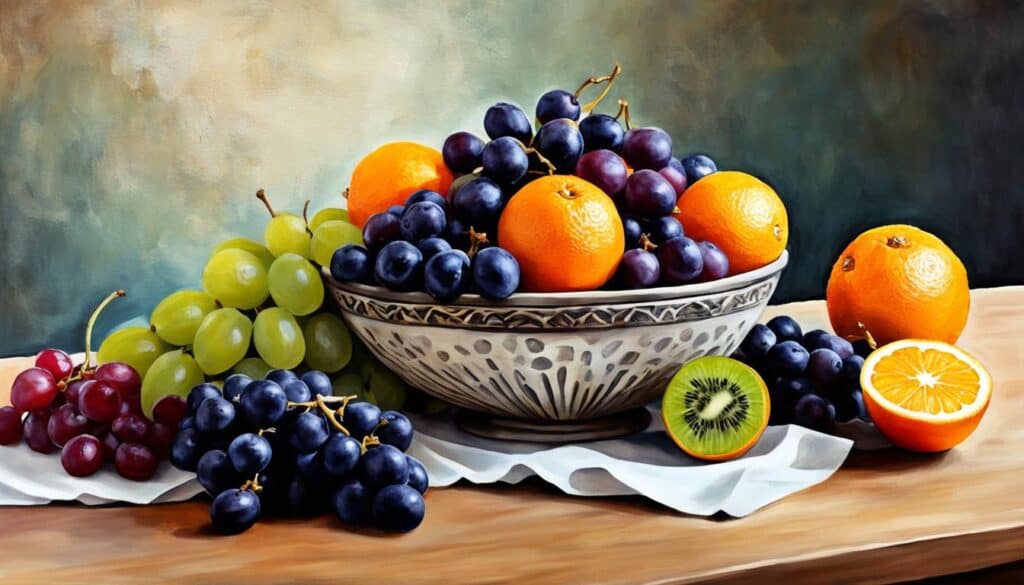
| Artist | Medium | Examples of Work |
|---|---|---|
| mariatriestoart | Oil pastels | 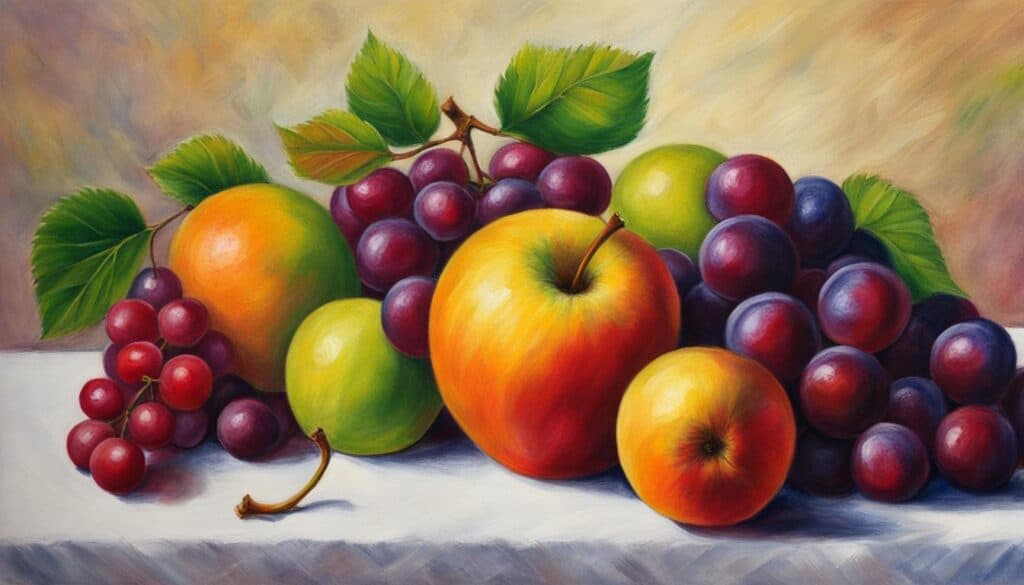 |
| black_aneri | Digital art | 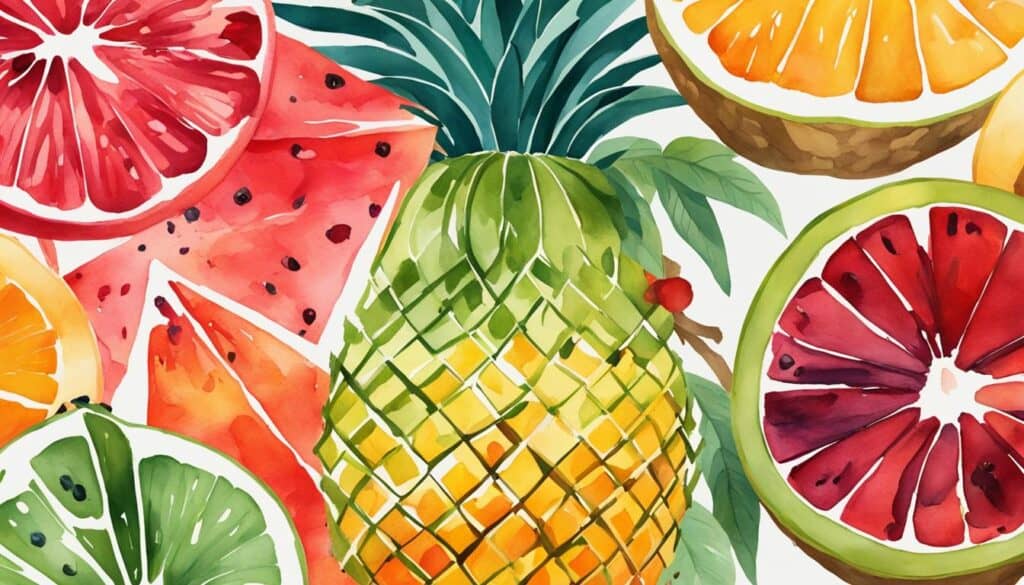 |
Painting Fruit Still Life
If you want to improve your still-life painting skills and have a fun activity for both kids and adults, why not try painting a fruit still life? It’s a great way to practice capturing the unique shapes, colors, and textures of various fruits.
Here’s a step-by-step guide on how to paint a fruit still life:
- First, gather a few different fruits of your choice. You can use three pears, bananas, or apples to create an interesting composition.
- Arrange the fruits in front of you, making sure to place them in a way that creates an appealing and balanced composition.
- Observe the unique details of each fruit, such as the curves, bumps, and colors. Pay attention to the shadows and highlights as well.
- Start sketching the basic shapes of the fruits on your canvas using a pencil. It’s okay if the sketch is not perfect; it’s just a guide for your painting.
- Select your desired colors and mix them on your palette. Take into account the natural colors of the fruits and the lighting conditions you’re aiming to portray.
- Begin painting by applying the base color to each fruit. Use light brushstrokes and gradually build up the colors and tones.
- Continue adding layers of paint to create depth and texture. Pay attention to the subtle variations in color and highlight areas where the light hits the fruits.
- Take breaks to step back and look at your painting from a distance. This will help you see any areas that need adjustments or additional details.
- Once you’re satisfied with your painting, let it dry completely before adding any final touches or details.
- Consider adding a background or other elements to enhance the composition. For example, you can include a fruit bowl or a piece of fabric for added visual interest.
- Finally, step back and admire your fruit still life painting. You’ve successfully captured the beauty and essence of the fruits through your artistic interpretation!
Remember: Painting fruit still lifes not only helps develop your observation skills, but it also allows you to experiment and have fun with colors and textures. So grab your brushes, set up your favorite fruits, and let your creativity flow with this enjoyable painting activity!
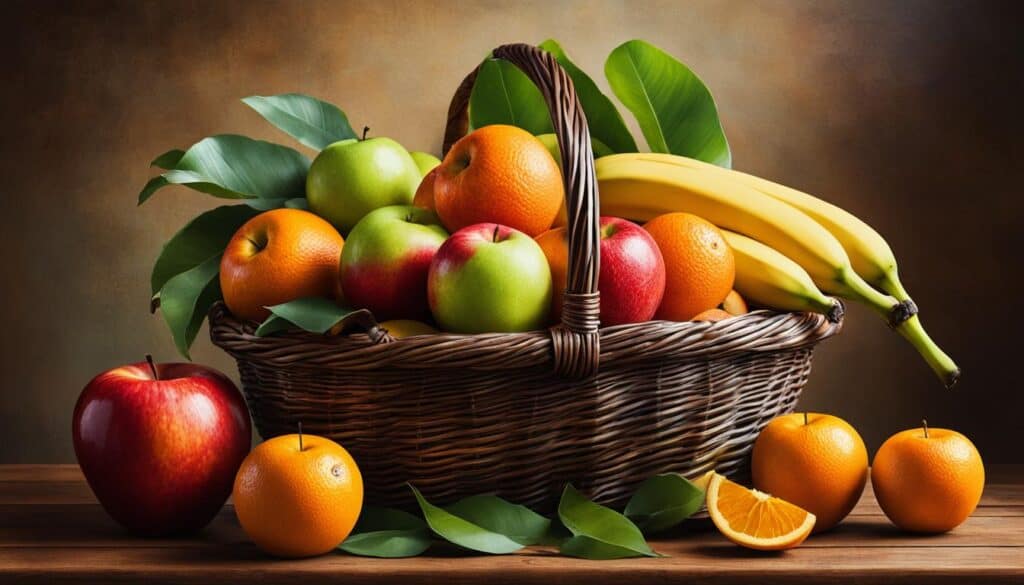
| Benefits of Painting Fruit Still Life |
|---|
| Improves observation skills |
| Enhances understanding of shapes, colors, and textures |
| Allows for experimentation with color mixing and brush techniques |
| Provides a relaxing and enjoyable artistic activity |
| Encourages creativity and artistic expression |
| Serves as a great subject for beginners and experienced artists alike |
Adding Elements to Fruit Paintings
To add interest and context to your fruit paintings, consider incorporating other elements into the composition. You can include a fruit bowl, a cutting board, or a backdrop of leaves to create a more complete scene. These additional elements not only provide visual interest but also offer opportunities to explore different textures and surfaces.
Creating a Complete Scene
By adding a fruit bowl or a cutting board to your fruit paintings, you can create a sense of context and realism. These elements can help convey the idea of a still life or a kitchen setting, enhancing the overall composition.
“When I paint fruits, I always make sure to include other elements that complement them. A fruit bowl or a plate with some slices adds depth and makes the painting more interesting.” – Emily Smith, Artist
In addition to fruit bowls and cutting boards, you can also experiment with different backdrops. Consider painting the fruit against a backdrop of leaves or a simple patterned fabric to add visual appeal and create contrast.
Exploring Textures and Surfaces
Adding elements to your fruit paintings can also provide an opportunity to explore different textures and surfaces. For example, a wooden cutting board can have a rough and grainy texture, while a fruit bowl can have a smooth and polished surface.
Take inspiration from the textures of the objects you include and try to capture their unique qualities in your paintings. Use brushstrokes and techniques that mimic the roughness of wood or the smoothness of ceramics to add depth and realism.
Example of Adding Elements to Fruit Paintings
| Fruit Paintings | Elements | Image |
|---|---|---|
| Still Life with Apples | Fruit Bowl | |
| Summer Fruit Composition | Leaves |
In the painting “Still Life with Apples,” the artist has incorporated a fruit bowl to create a sense of context and add visual interest. The fruit bowl not only complements the apples but also adds a contrasting texture and surface to the composition.
In “Summer Fruit Composition,” the artist has included a backdrop of leaves, creating a vibrant and dynamic scene. The leaves enhance the overall composition and add depth to the painting, making it more visually engaging.
By adding elements to your fruit paintings, you can elevate your artwork and create more compelling compositions. Experiment with different objects and textures to find the combination that inspires you and brings your fruit paintings to life.
Capturing Textures and Colors of Fruits
When it comes to fruit painting, one of the most exciting aspects is capturing the unique textures and vibrant colors that fruits offer. From the smoothness of apples to the roughness of kiwis, each fruit presents its own distinct surface that can be beautifully represented in your artwork.
To capture the textures of fruits in your paintings, experiment with different brushstrokes and techniques. For example, using short, quick brushstrokes can create the rough texture of a pineapple’s skin, while long, smooth brushstrokes can convey the velvet-like surface of a peach.
Additionally, the vibrant colors of fruits provide endless inspiration for mixing and blending different hues to achieve lifelike representations. By carefully observing and studying the colors of each fruit, you can create a palette that accurately reflects their shades. Don’t be afraid to experiment and play with color combinations to bring your fruit paintings to life.
Incorporating light and shadow is another technique that can add depth and dimension to your fruit paintings. By carefully observing how light interacts with each fruit, you can create realistic highlights and shadows that make your artwork more dynamic and engaging.
Remember, capturing the textures and colors of fruits is all about observation and experimentation. Take the time to closely study different fruits, their unique characteristics, and the way they reflect light. With practice, you’ll develop the skills to create realistic and captivating fruit paintings that truly showcase the beauty of nature’s bounty.
Quotes:
“The textures and colors of fruits offer endless inspiration for artists. Experimenting with different brushstrokes and techniques can help you bring a sense of realism to your paintings.” – ArtistName1
“Capturing the unique textures of fruits is a rewarding challenge for any artist. By observing and studying their surfaces, you can create paintings that evoke a tactile experience for the viewer.” – ArtistName2
Fruit Paintings with a Twist
When it comes to fruit paintings, don’t be afraid to unleash your creativity and add a unique twist to your artwork. By incorporating imaginative elements and personal touches, you can make your fruit paintings stand out and captivate viewers.
Here are some easy fruit art ideas to inspire you:
- Turn the stems of cherries into hearts for a whimsical touch.
- Incorporate leaves or flowers alongside the fruit to create a vibrant visual composition.
- Create a summer fruit composition with a variety of colorful fruits, capturing the essence of the season.
By playing around with these ideas, you can infuse your fruit paintings with your own personal style and make them truly unique.
“Art enables us to find ourselves and lose ourselves at the same time.” – Thomas Merton
Let Your Imagination Run Wild
When it comes to adding a twist to your fruit paintings, there are no limits. Embrace your imagination and explore different possibilities. You can experiment with abstract techniques, incorporate unexpected textures, or even reimagine the composition entirely. The key is to have fun and let your creativity guide you.
Here’s an example of a unique fruit painting with a twist:
| A fruit painting with a twist, featuring a surreal combination of fruits and vibrant colors. |
Remember, the goal is to create fruit paintings that captivate and inspire. Don’t be afraid to push boundaries, experiment with unconventional ideas, and let your artistic expression shine through.
Next, we’ll explore the reasons why fruit is a great subject for painting, offering even more inspiration for your fruit art journey.
Why Fruit is a Great Subject for Painting
Fruit is a versatile and captivating subject for painters of all skill levels. Whether you’re a novice artist looking for inspiration or an experienced painter seeking new ideas, fruit offers a wealth of possibilities. Here’s why fruit is an excellent choice for your next painting:
1. Simple Shapes and Forgiving Imperfections
Fruits, such as apples, pears, and oranges, often have straightforward shapes that are easy to capture on canvas. Their curves, contours, and unique forms provide an excellent foundation for honing your artistic skills. Even if your painting isn’t a perfect replica, the forgiving nature of fruit allows room for interpretation and creativity.
2. Vibrant Colors and Textures
The vivid hues and diverse textures of fruit create endless opportunities for exploration and experimentation. From the smooth skin of a ripe peach to the rough bumps of a pineapple, each fruit presents a chance to study and replicate its unique surface. The vibrant colors of fruits like strawberries, lemons, and watermelons allow you to play with bold palettes and create eye-catching compositions.
3. Accessibility and Availability
One of the advantages of fruit as a subject is its accessibility. You can find a wide variety of fruits in your local grocery store or market, making them easily obtainable for reference. Alternatively, you can use photographs as inspiration, capturing the essence of fruits from around the world without leaving your home.
By choosing fruit as your subject, you can embark on a creative journey that combines observation, technique, and personal expression. Whether you prefer realistic renderings or abstract interpretations, fruit painting offers a delightful and rewarding experience for artists of all backgrounds.
| Advantages of Fruit as a Painting Subject | Examples |
|---|---|
| Simple shapes and forgiving imperfections | Paintings of apples, pears, and oranges |
| Vibrant colors and textures | Artwork featuring strawberries, lemons, and watermelons |
| Accessibility and availability | Artists using grocery store fruit or photographs as references |
Conclusion
Painting fruit is an exciting and fulfilling artistic pursuit. Whether you prefer the delicate touch of watercolors, the versatility of acrylics, or want to explore other mediums, the world of fruit painting offers endless inspiration. By following these easy fruit painting ideas and tips, you can create stunning and vibrant artwork that will add a refreshing twist to your artistic journey.
With the colors and textures of fruits as your muse, let your creativity blossom. Embrace the beauty of a ripe peach, the lusciousness of a bunch of grapes, or the vibrant hues of a juicy watermelon. Give life to your canvas with bold brushstrokes and unique techniques.
So, grab your brushes, immerse yourself in the world of fruit painting, and let the natural beauty of these delicious subjects inspire you. Whether you are a beginner or an experienced artist, the appeal of fruit as a subject is undeniable. The simplicity and accessibility of fruit painting make it a perfect choice to unleash your artistic potential. So, let your imagination soar and create your next fruit-inspired masterpiece!
FAQ
Are there any easy fruit painting ideas?
Yes, there are plenty! Watercolor and acrylic paints offer a fun and accessible way to explore fruit painting. You can also experiment with other mediums such as oil pastels or digital art.
How can I improve my fruit painting techniques?
Pay attention to details such as seeds and textures, and experiment with light and shadow to add depth to your artwork. Observing and painting real fruits can also help improve your skills.
Any tips for painting fruits with watercolor?
Choose vibrant colors that are true to life, and use step-by-step tutorials as inspiration.
What are some acrylic fruit painting ideas?
Acrylic paints are great for beginners and offer a wide range of colors. You can experiment with techniques like layering and glazing to achieve different effects.
Can I use different mediums for fruit painting?
Absolutely! You can explore fruit painting with oil pastels or even digital art. There are no limits to your creativity.
How can I create still-life fruit paintings?
Arrange different fruits in front of you and paint what you see. This exercise helps you observe the unique shapes, colors, and textures of each fruit.
What can I add to my fruit paintings to make them more interesting?
Consider incorporating elements like fruit bowls, cutting boards, or backdrops of leaves to create a more complete scene.
How can I capture the textures and colors of fruits in my paintings?
Experiment with brushstrokes and techniques to recreate different fruit textures. Mix and blend colors to achieve lifelike representations.
Can I add a unique twist to my fruit paintings?
Absolutely! You can turn stems into hearts, incorporate other elements like leaves or flowers, or create summer fruit compositions with multiple fruits. Let your imagination run wild.
Why is fruit a great subject for painting?
Fruits offer simple shapes and forgiving imperfections, making them approachable for artists of all levels. Their vibrant colors and textures provide endless inspiration and opportunities for experimentation. Fruits are also readily available as subjects for painting.

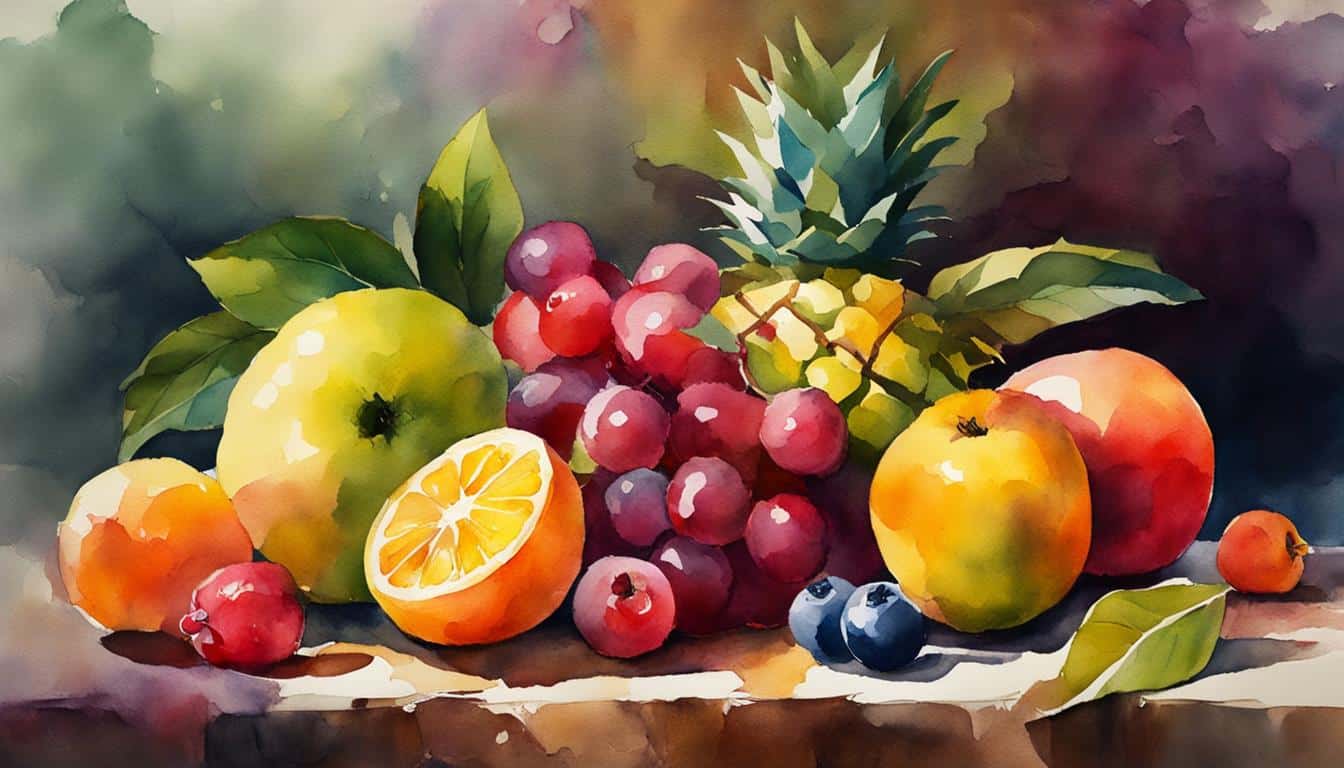



Leave a Reply